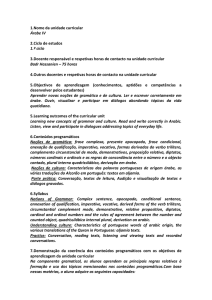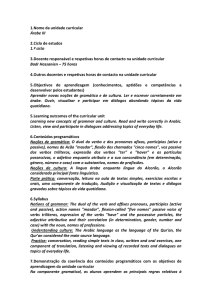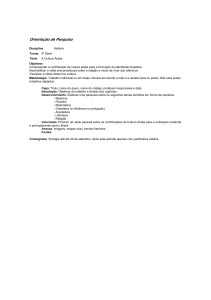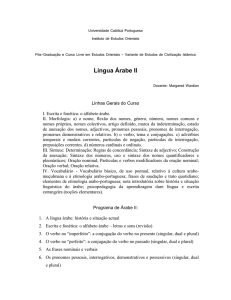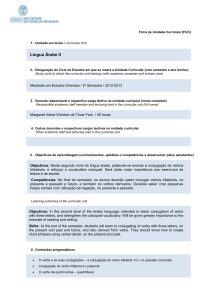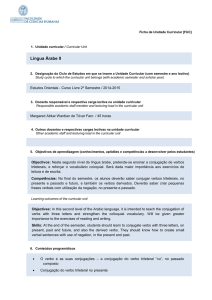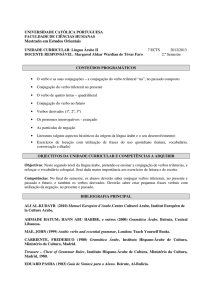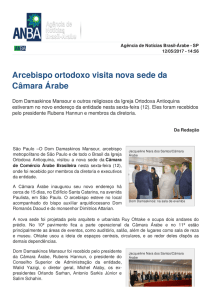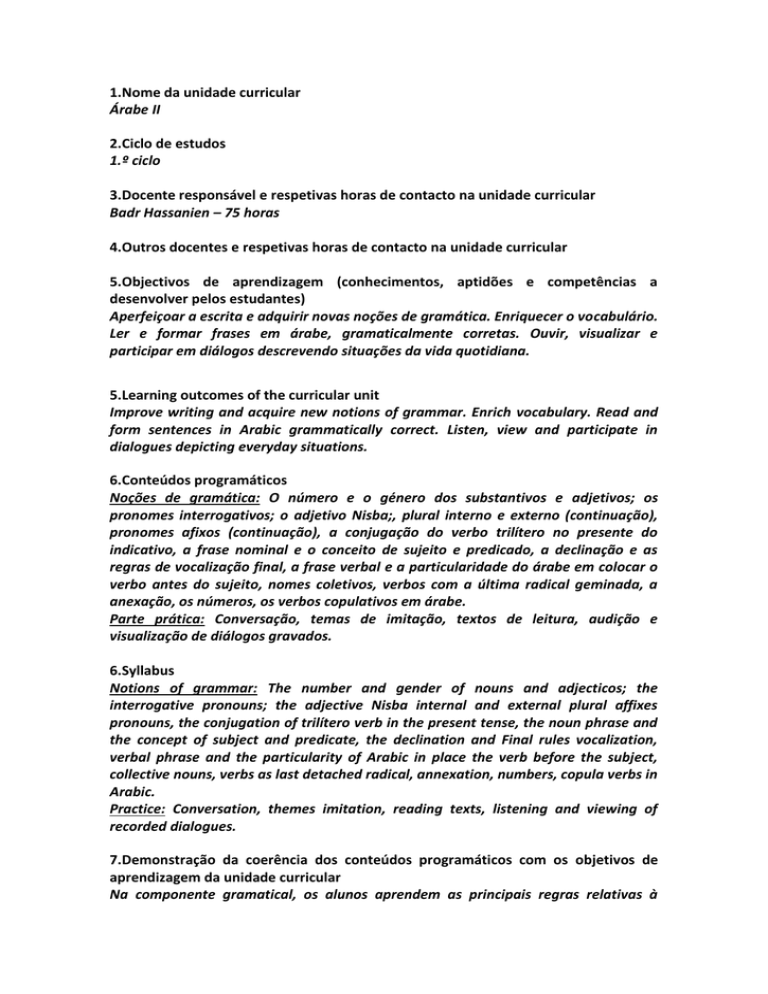
1.Nome da unidade curricular
Árabe II
2.Ciclo de estudos
1.º ciclo
3.Docente responsável e respetivas horas de contacto na unidade curricular
Badr Hassanien – 75 horas
4.Outros docentes e respetivas horas de contacto na unidade curricular
5.Objectivos de aprendizagem (conhecimentos, aptidões e competências a
desenvolver pelos estudantes)
Aperfeiçoar a escrita e adquirir novas noções de gramática. Enriquecer o vocabulário.
Ler e formar frases em árabe, gramaticalmente corretas. Ouvir, visualizar e
participar em diálogos descrevendo situações da vida quotidiana.
5.Learning outcomes of the curricular unit
Improve writing and acquire new notions of grammar. Enrich vocabulary. Read and
form sentences in Arabic grammatically correct. Listen, view and participate in
dialogues depicting everyday situations.
6.Conteúdos programáticos
Noções de gramática: O número e o género dos substantivos e adjetivos; os
pronomes interrogativos; o adjetivo Nisba;, plural interno e externo (continuação),
pronomes afixos (continuação), a conjugação do verbo trilítero no presente do
indicativo, a frase nominal e o conceito de sujeito e predicado, a declinação e as
regras de vocalização final, a frase verbal e a particularidade do árabe em colocar o
verbo antes do sujeito, nomes coletivos, verbos com a última radical geminada, a
anexação, os números, os verbos copulativos em árabe.
Parte prática: Conversação, temas de imitação, textos de leitura, audição e
visualização de diálogos gravados.
6.Syllabus
Notions of grammar: The number and gender of nouns and adjecticos; the
interrogative pronouns; the adjective Nisba internal and external plural affixes
pronouns, the conjugation of trilítero verb in the present tense, the noun phrase and
the concept of subject and predicate, the declination and Final rules vocalization,
verbal phrase and the particularity of Arabic in place the verb before the subject,
collective nouns, verbs as last detached radical, annexation, numbers, copula verbs in
Arabic.
Practice: Conversation, themes imitation, reading texts, listening and viewing of
recorded dialogues.
7.Demonstração da coerência dos conteúdos programáticos com os objetivos de
aprendizagem da unidade curricular
Na componente gramatical, os alunos aprendem as principais regras relativas à
formação e uso dos tópicos mencionados nos conteúdos programáticos.Com base
nessas matérias, a aluno adquire as seguintes capacidades:
Falar sobre si próprio, sua vida e seu ambiente e começar a ter conversas
sobre tópicos da vida quotidiana.
Ler textos simples e autênticos sobre tópicos familiares e compreender as
ideias principais sem uso do dicionário.
Escrever notas e ensaios sobre tópicos familiares relacionados com o dia-adia.
Compreender e produzir estruturas de frases em árabe.
Familiar-se com as diferenças, nos sons e estruturas básicas, entre o árabe
formal e o árabe falado.
Compreender aspetos da cultura árabe relacionados com o dia-a-dia,
incluindo expressões culturais importantes comummente usadas entre amigos
e familiares.
7.Demonstration of the syllabus coherence with the curricular unit's objectives
On the grammatical part, students learn the main rules about the formation and use
of the mentioned topics on the programmatic contents. Based on these subjects, the
student acquires the following skills:
Talk about himself, your life and his environment and start having
conversations about topics of everyday life.
Read simple authentic texts on familiar topics and understand the main ideas
without using a dictionary.
Write notes and essays on familiar topics related to the day-to-day.
Understand and produce structures of sentences in Arabic.
Familiar with the differences in the sounds and basic structures between
formal Arabic and spoken Arabic.
Understand aspects of Arab culture related to the day-to-day, including
important cultural expressions commonly used among friends and family.
8.Metodologias de ensino (avaliação incluída)
O método explicativo é usado na introdução à língua árabe, nas noções gramaticais
e dos textos. O método participativo é usado nos diálogos da conversa, na audição e
visualização dos suportes multimédia e na tradução dos textos árabes para
portuguesa e vice-versa. A avaliação dos alunos baseia-se em 4 elementos:
Dois testes escritos (60%),
Um teste oral no fim do semestre (20%),
Colaboração nas aulas, trabalhos de casa e portfolio (20%)
8.Teaching methodologies (including evaluation)
The explanatory method is used in the introduction to the Arabic language, the
grammatical concepts and texts. The participatory method is used in the dialogues of
the conversation, the listening and viewing of multimedia and the translation of
arabic texts into portuguese and vice versa.
The student evaluation is based on four elements:
Two written tests (60%)
An oral test at the end of the semester (20%)
Collaboration on classes, homework and portfolio (20%)
9.Demonstração da coerência das metodologias de ensino com os objetivos de
aprendizagem da unidade curricular
Com a combinação dos dois métodos de ensino (explicativo e participativo) usados,
os alunos adquirem os conhecimentos transmitidos e têm uma boa classificação nos
testes de avaliação. Verifica-se uma articulação entre a avaliação e os objetivos de
aprendizagem.
9.Demonstration of the coherence between the teaching methodologies and the
learning outcomes
With the combination of the two methods of teaching, students assimilate the
knowledge taught and have a good ranking in the evaluation tests. There is a link
between the evaluation and the learning objectives.
10.Bibliografia
Kristen Brustad, Mahmoud Al-Batal and Abbas Al-Tonsi, Al-Kitaab Fii Ta
Callum Al-cArabiyya: Part One, 3rd Edition, (2011).
António Dias Farinha, Curso de Árabe, Instituto de Estudos Árabes e Islâmicos,
Universidade de Lisboa, Faculdade de Letras, Lisboa, 2001.
Badr Hassanien, " O Particípio Passado em Português e Exame Contrastivo
com o Árabe", dissertação de mestrado, FLUL, Lisboa 1997.
Mohammad T. Alhawary, Modern Standard Arabic Grammar, WileyBlackwell, 2011.

